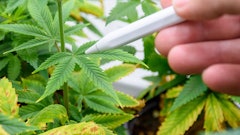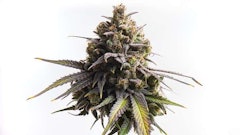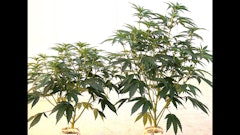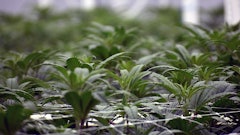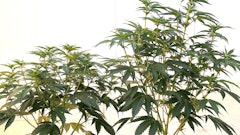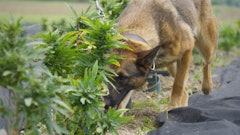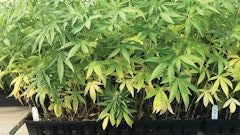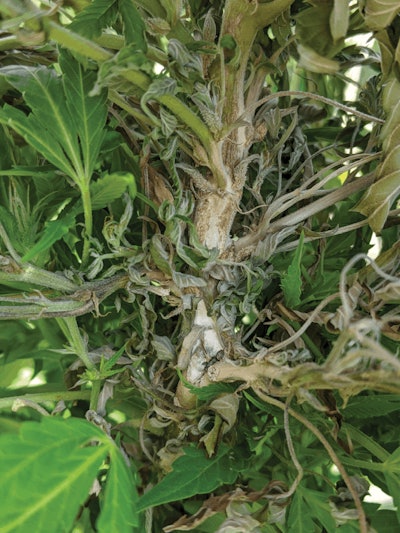
Reviewed December 2023
A recurring series focusing on plant cultivation by university researchers.
A wide assortment of insects and diseases, including white mold, find Cannabis sativa to be a suitable host. White mold is a disease caused by the pathogen Sclerotinia sp. While Sclerotinia sp. infections in outdoor cultivation are fairly common, incidences during indoor and greenhouse are rare.
What is white mold?
Sclerotinia sclerotiorum, commonly called white mold, is a pathogen that causes crown, root and stem rot, and has a host range of more than 400 plant species, according to the 2007 article “White mold (Sclerotinia),” written by Virginia Heffer Link and Kenneth B. Johnson of Oregon State University.
White mold has been reported in cannabis propagation and could be a cause for concern in growing operations. The fungus survives between growing seasons inside infected plants or in soil residue as hard, black resting structures called sclerotia (Fig. 1). These surviving sclerotia are the primary inoculum to infect the subsequent year’s crop. In a near-saturated, cool soil environment, sclerotia germinate and release spores through cup-like structures called apothecia to infect plant tissue. According to Heffer Link and Johnson, wet foliage or plant material in growing environments with temperatures of 54 to 75 degrees Fahrenheit (12 to 24 degrees Celsius) for one to two days can lead to spore germination, giving rise to infection.
Macroscopic Characteristics Sclerotinia species can be macroscopically identified by the white, cotton-like mycelium (Fig. 5) that can be present on the above-ground plant tissues two to four days after introduction when the spore lands. The mycelium produces enzymes, which cause water-soaked lesions on infected tissue. As the disease progresses, the mycelium clumps, eventually becoming the black, hardened sclerotia (Fig. 6). Stem bleaching and stem lodging (buckling) are also common symptoms of S. sclerotiorum infection, especially in hosts such as tomatoes. Older tissues, especially stems, may appear bleached and shredded with black, irregularly shaped sclerotia inside the dead tissue. White mold is a monocyclic disease, meaning it will not produce spores within the same growing season in which it infects plant tissue. Plant-to-plant spread of disease in the field is rare, but during high-density production in indoor or greenhouse-growing environments, it is possible.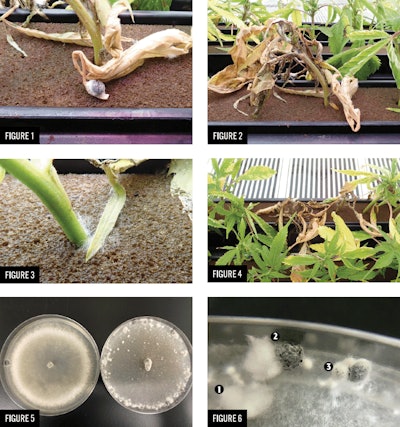
11 White Mold Management Options
Many disease management strategies exist, and when these practices are combined with an integrated pest management strategy, they can provide good control of white mold. In growing operations, these cultural practices are an integral part of disease management.
- Control moisture and humidity. These are the first steps in preventing or limiting white mold outbreaks. High humidity and moisture create a favorable environment for the pathogen and can lead to disease outbreaks.
- Employ proper air flow and spacing between plants to decrease humidity levels.
- Prune plants that have significant canopy growth to improve air movement.
- Create proper spacing so that plant canopies do not overlap, which could allow for disease to spread throughout the environment.
- Utilize drip irrigation and/or minimize the amount of overhead watering to help reduce excess moisture.
- Develop proper sanitation practices to limit disease pressure such as sterilizing substrate and other cultivation materials, avoiding growing plants in areas with a previous history of white mold, and managing weeds.
- Screen and clean seeds before planting to ensure that any seed-like black sclerotia are not introduced into the growing environment. The inspection process is akin to sifting through dry beans and lentils to be sure there are no stones before cooking.
- Keep an eye on your ventilation. In the case of the white mold outbreak observed in cannabis propagation, it is thought that the sclerotia outside the growing environment produced apothecia (fruiting bodies), which then released spores that entered the environment though the vents or cool cells.
- Implementing biological control, such as spraying Coniothyrium minitans spores on soil, has shown efficacy when used in an integrated pest management system for limiting disease. Because C. minitans is a living organism, cultivators must provide adequate time for it to establish and proliferate, and the application of this organism does not ensure that all sclerotia will be destroyed.
- Try to catch it early. As the pathogen infects and spreads throughout the host tissue, fungicides and biocontrol options for Sclerotinia control are not registered, nor effective.
- Discard infected plants as a primary control option. For propagation trays, also discard potentially contaminated, adjacent clones to avoid introducing the disease into your growing room or production fields.
White mold outbreaks during propagation can introduce the disease during production. Given the long-term survivability of sclerotia, the disease can persist for several years. Thus, identification and management of the disease is the best long-term strategy.















